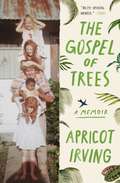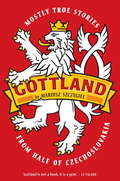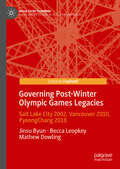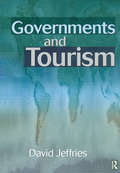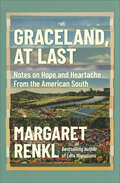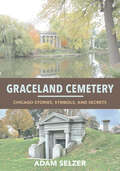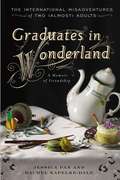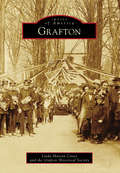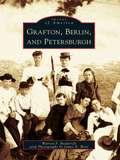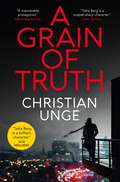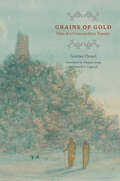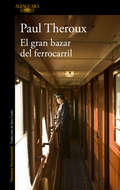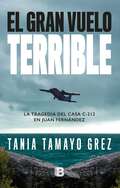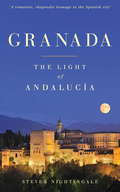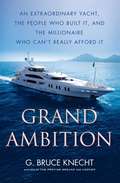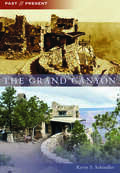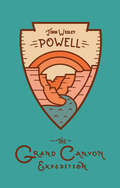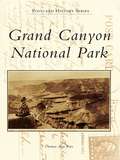- Table View
- List View
The Gospel of Trees: A Memoir
by Apricot IrvingIn this compelling, beautiful memoir, award-winning writer Apricot Irving recounts her childhood as a missionary’s daughter in Haiti during a time of upheaval—both in the country and in her home.Apricot Irving grew up as a missionary’s daughter in Haiti—a country easy to sensationalize but difficult to understand. Her father was an agronomist, a man who hiked alone into the hills with a macouti of seeds to preach the gospel of trees in a deforested but resilient country. Her mother and sisters, meanwhile, spent most of their days in the confines of the hospital compound they called home. As a child, this felt like paradise to Irving; as a teenager, the same setting felt like a prison. Outside of the walls of the missionary enclave, Haiti was a tumult of bugle-call bus horns and bicycles that jangled over hard-packed dirt, the clamor of chickens and cicadas, the sudden, insistent clatter of rain as it hammered across tin roofs and the swell of voices running ahead of the storm. As she emerges into womanhood, an already confusing process made all the more complicated by Christianity’s demands, Irving struggles to understand her father’s choices. His unswerving commitment to his mission, and the anger and despair that followed failed enterprises, threatened to splinter his family. Beautiful, poignant, and explosive, The Gospel of Trees is the story of a family crushed by ideals, and restored to kindness by honesty. Told against the backdrop of Haiti’s long history of intervention—often unwelcome—it grapples with the complicated legacy of those who wish to improve the world. Drawing from family letters, cassette tapes, journals, and interviews, it is an exploration of missionary culpability and idealism, told from within.
Gottland
by Antonia Lloyd-Jones Mariusz SzczygielWinner of the Europe Book PrizeOne of Europe's most preeminent investigative journalists travels to the Czech Republic--the Czech half of the former Czechoslovakia, the land that brought us Kafka--to explore the surreal fictions and the extraordinary reality of its twentieth century. For example, there's the story of the small businessman who adopted Henry Ford's ideas on productivity to create the world's largest shoe company--and hired modernist giants such as Le Corbusier to design his company towns (which were also the birthplaces of Ivana Trump and Tom Stoppard). Or the story of Kafka's niece, who loaned her name to writers blacklisted under the Communist regime so they could keep publishing.Or the story of the singer Karel Gott, winner of the country's Best Male Vocalist Award thirty-six years in a row, whose summer home, Gottland, is the Czech Dollywood. Based on meticulous research and hundreds of interviews with everyone from filmmakers to writers to pop stars to ordinary citizens, Gottland is a kaleidoscopic portrait of a resilient people living through difficult and often bizarre times--equally funny, disturbing, stirring and absurd . . . in a word, Kafkaesque.From the Hardcover edition.
Governing Post-Winter Olympic Games Legacies: Salt Lake City 2002, Vancouver 2010, PyeongChang 2018 (Mega Event Planning)
by Jinsu Byun Becca Leopkey Mathew DowlingThis book provides a comprehensive analysis of post-Games legacy governance including stakeholder relationships, institutional conditions, and policy environments, while also empirically exploring the modes of governance employed by select cases of the Winter Olympic Games. This work offers insights to help practitioners develop and manage the governance of legacy more effectively. Theoretical and methodological implications, as well as future avenues of research are suggested.
Governments and Tourism
by David Jeffries'Governments and Tourism' is a unique text that studies the general and specific tourism policies from central to local government. Through case studies from around the world, including the UK, USA and France, the role and function of Official Tourism Administrations (OTAs) are evaluated. Governments and Tourism is essential reading for busy practitioners,who wish to know:* How different countries and communities have coped with the opportunities and threats posed by tourism* How they plan to address future opportunities and thresats posed by tourism* What lessons can be applied elsewhere* What should be the complementary functions of the public and private sectors
Graceland, At Last: Notes on Hope and Heartache From the American South
by Margaret Renkl“In this luminous collection” a New York Times columnist “delivers smart, beautifully crafted personal and political observations” on the American south (Minneapolis Star Tribune).Margaret Renkl’s New York Times columns offer readersa weekly dose of natural beauty, human decency, and persistent hope from her home in Nashville. Now more than sixty of those pieces have been brought together in this sparkling collection.“People have often asked me how it feels to be the ‘voice of the South,’” writes Renkl in her introduction. “But I’m not the voice of the South, and no one else is, either.” There are many Souths—red and blue, rural and urban, mountain and coast, Black and white and brown—and no one writer could possibly represent all of them. In Graceland, At Last, Renkl writes instead from her own experience about the complexities of her homeland.In a patchwork quilt of essays, Renkl also highlights other voices of the South. Teenagers who organized a youth march for Black Lives Matter. An urban shepherd whose sheep remove invasive vegetation. Church parishioners sheltering the homeless. Throughout, readers will find a generosity of spirit and deep attention to the world, human and nonhuman. From a writer who “makes one of all the world’s beings” (NPR), Graceland, At Last is a book for Southerners and non-Southerners alike.“E.B. White suggested that newspapers cover nature as eagerly as commerce. . . . Renkl . . . seems like a belated answer to White . . . [crafting] graceful sentences that White would surely have enjoyed.” —Wall Street Journal“Margaret Renkl’s perspective feels like a guiding light . . . No matter where you’re from, column after column, Renkl will make you feel right at home.” ?Pittsburgh Post-Gazette
Graceland Cemetery: Chicago Stories, Symbols, and Secrets
by Adam SelzerOne of Chicago’s landmark attractions, Graceland Cemetery chronicles the city’s sprawling history through the stories of its people. Local historian and Graceland tour guide Adam Selzer presents ten walking tours covering almost the entirety of the cemetery grounds. While nodding to famous Graceland figures from Marshall Field to Ernie Banks to Ludwig Mies van der Rohe, Selzer also leads readers past the vaults, obelisks, and other markers that call attention to less recognized Chicagoans like: Jessie Williams de Priest, the Black wife of a congressman whose 1929 invitation to a White House tea party set off a storm of controversy; Engineer and architect Fazlur Khan, the Bangladeshi American who revived the city's skyscraper culture; The still-mysterious Kate Warn (listed as Warn on her tombstone), the United States’ first female private detective. Filled with photographs and including detailed maps of each tour route, Graceland Cemetery is an insider's guide to one of Chicago's great outdoor destinations for city lore and history.
Graduates in Wonderland
by Rachel Kapelke-Dale Jessica PanTwo best friends document their post-college lives in a hilarious, relatable, and powerfully honest epistolary memoir. Fast friends since they met at Brown University during their freshman year, Jessica Pan and Rachel Kapelke-Dale vowed to keep in touch after their senior year through in-depth--and brutally honest--weekly e-mails. After graduation, Jess packs up everything she owns and moves to Beijing on a whim, while Rachel heads to New York to work for an art gallery and to figure out her love life. Each spends the next few years tumbling through adulthood and reinventing themselves in various countries, including France, China, and Australia. Through their messages from around the world, they swap tales of teaching classes of military men, running a magazine, and flirting in foreign languages, along with the hard stuff: from harrowing accidents to breakups and breakdowns. Reminiscent of Sloan Crosley's essays and Lena Dunham's Girls, Graduates in Wonderland is an intimate, no-holds-barred portrait of two young women as they embark upon adulthood.
Grafica della Strada: The Signs of Italy
by Louise FiliFor more than three decades, renowned graphic designer and self-described Italophile Louise Fili has traveled the cities and countryside of Italy cataloging the work of sign craftsmen in whose hands type takes on new life with a tantalizing menu of styles. Classical, eclectic, or Futurist; in gold leaf, marble, brass, wood, wrought iron, enamel, ceramic, or neon; painted, carved, inlaid, etched, tiled, or stenciled— the creative possibilities are endless. Grafica della Strada is Fili's photographic diary of hundreds of Italy's most inventive restaurant, shop, hotel, street, and advertising signs. A major influence on Fili's own work, many of these marvels of vernacular design live on solely in this book, a typographic love letter to Italy that will be an inspiration to designers and Italophiles everywhere.
Grafica della Strada
by Louise FiliFor more than three decades, renowned graphic designer and self-described Italophile Louise Fili has traveled the cities and countryside of Italy cataloging the work of sign craftsmen in whose hands type takes on new life with a tantalizing menu of styles. Classical, eclectic, or Futurist; in gold leaf, marble, brass, wood, wrought iron, enamel, ceramic, or neon; painted, carved, inlaid, etched, tiled, or stenciled-- the creative possibilities are endless. Grafica della Strada is Fili's photographic diary of hundreds of Italy's most inventive restaurant, shop, hotel, street, and advertising signs. A major influence on Fili's own work, many of these marvels of vernacular design live on solely in this book, a typographic love letter to Italy that will be an inspiration to designers and Italophiles everywhere.
Grafton (Images of America)
by Linda Marean Casey Grafton Historical SocietyNestled in the hills 38 miles west of Boston, the area that would become Grafton originally belonged to the Nipmuc Indians. In the mid-1600s, John Eliot, a Puritan missionary, traveled throughout Massachusetts converting the natives to Christianity. He created a series of "praying Indian" villages, including Hassanamesit. In 1728, most of Hassanamesit was purchased by a group of investors, and in 1735 it was incorporated as the town of Grafton. By the early 19th century, Grafton was a national leader in leather tanning and shoe production. Textile mills appeared along the rivers, attracting emigrant workers from Canada and Europe. Three geographic areas evolved, each with its own identity: Grafton Center, North Grafton, and South Grafton. Today, residents celebrate the differences and salute the forces that brought them together to form one united town. Grafton is the birthplace of the famous Willard clock makers--Simon, Benjamin, Ephraim, and Aaron--whose home and clock shop are now the Willard House and Clock Museum. Grafton is the birthplace of Robert Bailey Thomas, the founder, editor, and publisher of the Old Farmer's Almanac. Native Jerome Wheelock invented a steam valve system, revolutionizing transportation worldwide. Grafton is also the childhood home of noted American poet Frank O'Hara.
Grafton, Berlin, and Petersburgh (Images of America)
by Warren F. Broderick James E. WestGrafton, Berlin, and Petersburgh captures a vivid picture of a long lost way of life in upstate New York. Filled with unforgettable photographs by James E. West, the book artistically portrays the proud people, quiet streets, and breathtaking panoramas of eastern Rensselaer County from1880 to 1915. For the first time, these historical photographsfrom the West collection are presented in a single volume. Anative of Grafton, James Emmett West set up a photographic business in 1878, began working in earnest in the Grafton-Berlin-Petersburgh region, and traveled in hishorse-drawn wagon, f ully equipped with a studio and darkroom.
A Grain of Truth
by Christian UngeStressed-out, sleep-deprived and pill-popping Dr Tekla Berg is as unusual a central character as you will find" Irish Independent"Tekla is a terrific character" Literary Review"Tekla Berg is a brilliant character" Susi Holliday"A memorable protagonist" Imran Mahmood"Tekla is a scalpel-sharp character" Jens LapidusA woman is found wandering the corridors of Nobel Hospital in Stockholm, accompanied by a young boy. She appears to be looking for a man who was involved in a car accident earlier that day.Meanwhile, in one of the emergency rooms, Tekla Berg is fighting to save a patient who was seriously injured in the same incident. The resulting chaos goes beyond anything anyone could have predicted, leaving hospital staff, police and everyone else involved equally shocked and perplexed.Hospital Director Monica Carlsson has stepped up her attempts to privatise her fiefdom with the launch of an exclusive patient hotel, a controversial liver transplant unit and the prestigious recruitment of star surgeon Klas Nyström. It soon becomes obvious that Klas has his own agenda and is working to undermine Tekla at every turn.But Tekla is too distracted to meet this challenge head on: she has become obsessed with the mystery surrounding the woman and her young charge - for the boy's identity remains unknown and no trace of his past can be found.Reviews for Hell and High Water"A gripping crime novel . . . fast-moving and packed with convincing detail and memorable characters" Literary Review"As gripping as it could be . . . An authentic and seriously exciting debut" Irish IndependentTranslated from the Swedish by George Goulding and Sarah de Senarclens
A Grain of Truth
by Christian UngeStressed-out, sleep-deprived and pill-popping Dr Tekla Berg is as unusual a central character as you will find" Irish Independent"Tekla is a terrific character" Literary Review"Tekla Berg is a brilliant character" Susi Holliday"A memorable protagonist" Imran Mahmood"Tekla is a scalpel-sharp character" Jens LapidusA woman is found wandering the corridors of Nobel Hospital in Stockholm, accompanied by a young boy. She appears to be looking for a man who was involved in a car accident earlier that day.Meanwhile, in one of the emergency rooms, Tekla Berg is fighting to save a patient who was seriously injured in the same incident. The resulting chaos goes beyond anything anyone could have predicted, leaving hospital staff, police and everyone else involved equally shocked and perplexed.Hospital Director Monica Carlsson has stepped up her attempts to privatise her fiefdom with the launch of an exclusive patient hotel, a controversial liver transplant unit and the prestigious recruitment of star surgeon Klas Nyström. It soon becomes obvious that Klas has his own agenda and is working to undermine Tekla at every turn.But Tekla is too distracted to meet this challenge head on: she has become obsessed with the mystery surrounding the woman and her young charge - for the boy's identity remains unknown and no trace of his past can be found.Reviews for Hell and High Water"A gripping crime novel . . . fast-moving and packed with convincing detail and memorable characters" Literary Review"As gripping as it could be . . . An authentic and seriously exciting debut" Irish IndependentTranslated from the Swedish by George Goulding and Sarah de Senarclens
Grains of Gold: Tales of a Cosmopolitan Traveler (Buddhism and Modernity)
by Gendun Chopel“Translated with grace and precision . . . gives us a rare glimpse of how Asian religion and life appeared from the perspective of the Tibetan plateau.” —Janet Gyatso, Harvard UniversityIn 1941, philosopher and poet Gendun Chopel sent a manuscript by ship, train, and yak across mountains and deserts to his homeland in Tibet. He would follow it five years later, returning to his native land after twelve years in India and Sri Lanka. But he did not receive the welcome he imagined: he was arrested by the government of the regent of the young Dalai Lama on trumped-up charges of treason. He emerged from prison three years later a broken man and died soon after. Gendun Chopel was a prolific writer, yet he considered that manuscript, to be his life’s work, one to delight his compatriots with tales of an ancient Indian and Tibetan past, Now available for the first time in English, Grains of Gold is a unique compendium of South Asian and Tibetan culture that combines travelogue, drawings, history, and ethnography. Chopel describes the world he discovered in South Asia, from the ruins of the sacred sites of Buddhism to the Sanskrit classics he learned to read in the original. He is also sharply, often humorously critical of the Tibetan love of the fantastic, bursting one myth after another and finding fault with the accounts of earlier Tibetan pilgrims. The work of an extraordinary scholar, Grains of Gold is a compelling work animated by a sense of discovery of both a distant past and a strange present.“The magnum opus of arguably the single most brilliant Tibetan scholar of the twentieth century.” —Lauran Hartley, Columbia University
El gran bazar del ferrocarril
by Paul TherouxLa crónica de un viaje por Turquía, Extremo Oriente y Siberia, con el tren como lugar de encuentro, que inauguró un nuevo género de literatura de viajes. Desde niño, Paul Theroux no es capaz de escuchar el silbido de un tren sin sentir un deseo imperioso de subirse a él. Ahora bien, al contrario que el viajero tradicional, que utiliza este medio de transporte de forma meramente utilitaria para llegar a su destino, lo que a Theroux le interesa son los ferrocarriles mismos. Quiere conocerlos todos, y para ello se propone ir desde la londinense estación de Victoria hasta Tokio saltando a todos los que encuentre a su paso. Reseñas:«En la mejor tradición del viaje sin otro propósito que la diversión y la aventura. Una lectura compulsiva.»Graham Greene «Divertido, sardónico, extremadamente sensible... y muy ameno.»The New York Times
El gran vuelo terrible
by Tania Tamayo GrezInvestigación periodística que indaga las razones del accidente sufrido por el Casa 212 que llevaba una tripulación civil a la isla Juan Fernández, entre ellos, al animador Felipe Camiroaga y al director de Levantemos Chile, Felipe Cubillos, tragedia que remeció al país. El viernes 2 de septiembre de 2011 se precipitó al mar el avión de la Fach cuyo nombre de combate era Pegaso. Los 21 pasajeros que iban en el vuelo llevaban ayuda a la isla para colaborar en las tareas de reconstrucción luego del terremoto y tsunami de 2010. Todos murieron. Las causas nunca fueron claras: una nave militar trasladó como carga a 21 pasajeros civiles y se cometieron una serie de irregularidades y negligencias que ahora, en este libro, salen a la luz.
Granada: A Pomegranate in the Hand of God
by Steven NightingaleAndalusia: ancient homeland of the mysterious Iberians, birthplace of Roman emperors, seedbed of modern Anarchism, and unmarked gravesite of Spain's greatest lyric poet. Perhaps most importantly, Andalusia is home to the city of Granada, where a hybrid culture composed of Islamic, Jewish, and Christian traditions gave rise to an intellectual vanguard whose achievements can be compared only with those of classical Athens, Ming China, or Renaissance Italy. Granada resident Steven Nightingale excavates the rich past of his adopted city and its surrounding countryside, finding there a lavish story of utopian ecstasy, political intrigue, and finally anguish. Part of that region in southern Spain named by its Islamic rulers "Al-Andalus," medieval Granada witnessed a flourishing of poetry in several languages, the first modern translations of Greek philosophy, the birth of algebra, and the construction of architectural masterpieces such as the Alhambra and the Generalife. Yet with Ferdinand and Isabella's sack of Granada in 1492, regarded as the culmination of the Reconquista, which sought to reclaim Spain for the Vatican, a Catholic mythology of Spain began to erode Granada's centuries-old reputation as an artistically vital haven for multiple ethnic and religious groups. Linking the disastrous afterlife of the Reconquista to the Catholic nationalism of the Franco regime-whose execution of Granadan poet Federico Garcia Lorca symbolizes the suppression of Andalusia's cultural heritage-Nightingale demonstrates the extent to which this Catholic triumphalism also obscured the source of much cultural wealth bequeathed by Al-Andalus to Christian Europe. Nightingale's own account of the region's medieval zenith recovers the intellectual pageantry and aesthetic splendor of this astounding period in Western history and the marvelous city that was its cultural center.
Granada: The Light of Andalucía
by Steven NightingaleAN INDEPENDENT TRAVEL BOOK OF THE YEARA TELEGRAPH TRAVEL BOOK OF THE YEARYearning for a change, Steven Nightingale took his family to live in the ancient Andalucian city of Granada. But as he journeyed through its hidden courtyards, scented gardens and sun-warmed plazas, Steven discovered that Granada's present cannot be separated from its past, and began an eight-year quest to discover more. Where once Christians, Muslims and Jews lived peacefully together and the arts and sciences flourished, Granada also witnessed brutality: places of worship razed to the ground, books burned, massacre and anarchy. In the 1600s the once-populous city was reduced to 6,000 who lived among rubble. In the next three centuries, the deterioration worsened, and the city became a refuge for anarchists; then during the Spanish Civil War, fascism took hold. Literary and sensual, Steven Nightingale produces a portrait of a now-thriving city and the joy he discovered there, revealing the resilience and kindness of its people, the resonance of its gardens and architecture and the cyclical nature of darkness and light in the history of Andalucia. At once personal and far-reaching, Granada is an epic journey through the soul of this most iconic of cities.
Granada Hills
by Jim HierThe modern history of Granada Hills began in 1913 with the completion of the Los Angeles aqueduct and the arrival of abundant freshwater to the former land of Mission San Fernando. Citrus orchardsflourished on the Sunshine Ranch, acreage originally cultivated by former senator George K. Porter. In 1926, the community of Granada was formed as a rabbit-raising colony, promising residents country living and economic prosperity. Granada added "Hills" to its name in 1942 to avoid confusion with a similarly named Northern California town, andthanks to the postwar baby boom, the population grew by 1,000 percent between 1950 and 1960. The community soon earned a reputation as "The San Fernando Valley's Most Neighborly Town" as residents came together to celebrate the hometown team's 1963 Little League World Series victory and the formation of the nation's first all-girl American Youth Soccer Organization league, and as neighbor helped neighborafter the devastating 1971 and 1994 earthquakes.
Grand Ambition: An Extraordinary Yacht, the People Who Built It, and the Millionaire Who Can't Really Afford It
by G. Bruce KnechtG. Bruce Knecht, former reporter for The Wall Street Journaland author of The Proving Ground and Hooked, describes the creation of an outsized yacht in a sweeping narrative centered on the men and women who made it happen.Doug Von Allmen, a self-made man who grew up in a landlocked state dreaming of the ocean, was poised to build a 187-foot yacht that would cost $40 million. Lady Linda would not be among the very largest of the burgeoning fleet of oceangoing palaces, but Von Allmen vowed that it would be the best one ever made in the United States. Nothing would be ordinary. The interior walls would be made from rare species of burl wood, the floors paved with onyx and exotic types of marble, the furniture custom made, and the art specially commissioned. But the 2008 economic crisis changed everything. Von Allmen&’s lifestyle suddenly became unaffordable. Then it got worse: desperate to reverse his losses, he fell for an audacious Ponzi scheme. Would Von Allmen be able to complete Lady Linda? Would the shipyard and its one thousand employees survive the financial meltdown? The divide between the very rich and everyone else had never been greater, yet the livelihoods of the workers, some of them illegal immigrants, and the yacht owners were inextricably intertwined. In a sweeping, high-stakes narrative, the critically acclaimed author of The Proving Ground and Hooked weaves Von Allmen&’s story together with those of the men and women who are building his yacht. As the pursuit of opulence collides with the reality of economic decline, everyone involved in the massive project is forced to rethink the meaning of the American Dream.
Grand Avenue:The Story of the French Visionary Who Designed Washington DC
by Scott W. BergGrand Avenues tells the riveting story of Pierre Charles L'Enfant and the creation of Washington, D.C. from the seeds of his inspiration to the fulfillment of his extraordinary vision. L'Enfant's story is one of consuming passion, high emotion, artistic genius, and human frailty. As a boy he studied drawing at the most prestigious art academy in the world. As a young man he left his home in Paris to volunteer in the army of the American colonies, where he served under George Washington. There he would also meet many of the people who would have a profound impact on his life, including Alexander Hamilton and James Monroe. And it was Washington himself who, in 1791, entrusted L'Enfant with the planning of the nation's capital and reluctantly allowed him to be dismissed from the project eleven months later. The plan for the city was published under another name, and for the remainder of his life L'Enfant fought for recognition of his achievement. But he would not live to see that day, and a century would pass before L'Enfant would be given credit for his brilliant design. Scott W. Berg recounts this tale, richly evocative of time and place, with the narrative verve of a novel and a cast of characters that ranges from Thomas Jefferson and the other Founding Fathers to the surveyor who took credit for L'Enfant's plans, the assistant who spent a week in jail for his loyalty to L'Enfant, and the men who finally restored L'Enfant's reputation at the beginning of the twentieth century. Here is a fascinating, little-explored episode in American history: the story of a visionary artist and of the founding of the magnificent city that is his enduring legacy.
The Grand Canyon (Past and Present)
by Kevin Scott SchindlerThe Grand Canyon is one of the most inspiring and accessible natural wonders in the world. More than a century ago, visionaries developed it as a tourist destination, and today, it sees more than five million visitors per year to experience its geology, cultural history, and wildlife. Relying on historic images primarily from the Grand Canyon Museum Collections, historian Kevin S. Schindler traces the development of the Grand Canyon as a bucket-list destination for people of all ages. Comparing our present to our past is how we understand our history. Arcadia's Past & Present series makes such local comparisons available. Books in this series offer a special view of American life by placing historical images side by side with contemporary photographs.
The Grand Canyon Expedition: The Exploration Of The Colorado River And Its Canyons
by John Wesley PowellThe geologist and explorer’s own account of his perilous venture into one of the last unmapped portions of the continental United States.Join John Wesley Powell’s expedition to explore one of the Seven Wonders of the Natural World, and one of the last unmapped portions of the continental United States. Powell’s detailed descriptions of the rocks, plants, and animals seen in the canyon; the geography of the area; his team’s interactions with native groups; and dangers and mishaps along the trail allow readers to feel the thrill, the awe, and the humility of standing on the canyon’s edge.After losing an arm in the Civil War, the young Powell took on an extraordinary challenge as he led a small team into this remarkable landscape. He would go on to become the director of the US Geological Survey and the Smithsonian, and is acknowledged today for his foresight on the importance of conserving natural resources—particularly water—as the nation rapidly expanded westward.“Powell’s ideas powerfully shaped development of the West’s water supply.” —Scientific American “He had entered the Grand Canyon as a pioneer, hoping that it could be exploited and settled, but the experience changed him. He realized that the presence of indigenous peoples, the landscape, water and ecosystems meant that it could not and should not be settled as the Eastern states had been. Now, as the Western states are threatened with a catastrophic water shortage, it is possible that he should be remembered not just as an explorer, but also as a prophet.” —BBC News Magazine
Grand Canyon National Park
by Thomas Alan RatzArizona is proud to have one of the Seven Natural Wonders of the World--the Grand Canyon. With the arrival of the Santa Fe and Union Pacific Railroad in the early 20th century, the development of the canyon began in earnest. The railroads, along with the Santa Fe's business partner, the Fred Harvey Company, greatly promoted the Grand Canyon as a tourist destination through books, pamphlets, and magazine advertisements. On February 26, 1919, Congress established the Grand Canyon National Park, and the federal government became a promoter of the Grand Canyon, too. But perhaps the best promoters of the Grand Canyon were the people who wrote home on picture postcards telling their friends and families about the amazing canyon. A number of the postcards published about the park can be found within the pages of this book.
